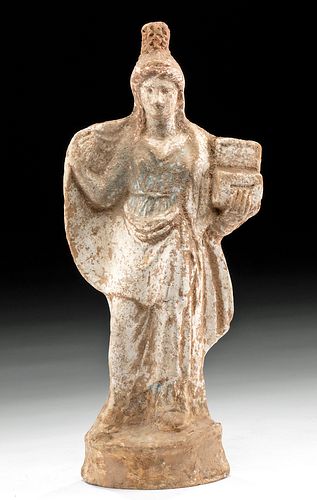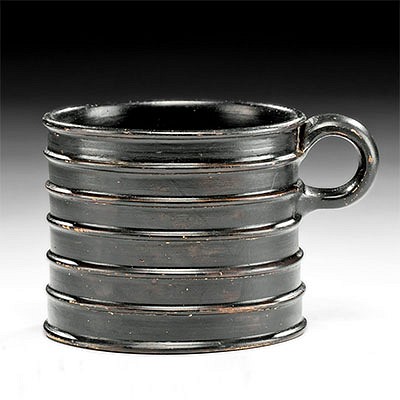Greek Hellenistic Canosan Polychrome Female Figure
Lot 38
About Seller
Artemis Fine Arts
686 S Taylor Ave, Ste 106
Louisville, CO 80027
United States
Selling antiquities, ancient and ethnographic art online since 1993, Artemis Gallery specializes in Classical Antiquities (Egyptian, Greek, Roman, Near Eastern), Asian, Pre-Columbian, African / Tribal / Oceanographic art. Our extensive inventory includes pottery, stone, metal, wood, glass and textil...Read more
Categories
Estimate:
$2,000 - $3,000
Absentee vs Live bid
Two ways to bid:
- Leave a max absentee bid and the platform will bid on your behalf up to your maximum bid during the live auction.
- Bid live during the auction and your bids will be submitted real-time to the auctioneer.
Bid Increments
| Price | Bid Increment |
|---|---|
| $0 | $25 |
| $300 | $50 |
| $1,000 | $100 |
| $2,000 | $250 |
| $5,000 | $500 |
| $10,000 | $1,000 |
| $20,000 | $2,500 |
| $50,000 | $5,000 |
| $100,000 | $10,000 |
| $200,000 | $20,000 |
About Auction
By Artemis Fine Arts
Mar 12, 2020
Set Reminder
2020-03-12 10:00:00
2020-03-12 10:00:00
America/New_York
Bidsquare
Bidsquare : Ancient / Ethnographic Around The World
https://www.bidsquare.com/auctions/artemis-gallery/ancient-ethnographic-around-the-world-4957
Ancient art from Egypt, Greece, Italy and the Near East, as well as Asian, Fossils, Pre-Columbian, Native American, African / Tribal / Oceanic, Spanish Colonial, Russian Icons, Fine art, much more! Artemis Fine Arts info@artemisfinearts.com
Ancient art from Egypt, Greece, Italy and the Near East, as well as Asian, Fossils, Pre-Columbian, Native American, African / Tribal / Oceanic, Spanish Colonial, Russian Icons, Fine art, much more! Artemis Fine Arts info@artemisfinearts.com
- Lot Description
Magna Graecia, Apulia, Canosan, Hellenistic Period, ca. mid-4th to early 2nd century BCE. An attractive, mold-formed pottery goddess figure standing in contrapposto atop an integral tiered base. The white-painted woman balances her body with her left leg while bending her right knee, holds open a shawl draped across her shoulders, grasps a rectangular box in her left arm, and wears a wavy peplos decorated with powder-blue pigment. Her stern visage features downcast, almond-shaped eyes, a broad nose above full lips, elegantly contoured cheeks, and a smooth brow, and her centrally bound, maroon-hued coiffure bears hanging bangs and a rippled top bun. Delicate figures like this example were typically intended as votive funerary offerings. Size: 4.9" W x 11.2" H (12.4 cm x 28.4 cm)
Female figures like this one played an interesting role in Canosan funerary practices as they were placed into Canosan tombs as replacements for large red-figure krater amphorae from the previous century; first, however, mourners had to carry these figures in funerary processions and keep them present while carrying out rituals at and inside the tomb. Virtually all of the statues known from Canosan tombs depict women. However, scholars believe that they represented goddesses or mourners rather than the gender of the deceased individual; young women played a major role as mourners in this society. The Canosans, like other members of Classical society, believed that the spirits of the dead remained at the tomb and watched over the living. Canosan tombs were frequently re-opened to entomb deceased members of the same familial lineage, and this suggests that these statues were perhaps reused to maintain the spiritual connection between the living and the dead.
Provenance: private East Coast, USA collection, acquired in December 2019; ex-Arte Primitivo Gallery, New York, New York, USA (auction #96, December 3, 2019, lot 499); ex-private New York, New York, USA and Paris, France collection, acquired in the 1970s to 1980s; ex-La Reine Margot, Paris, France, 1970s to 1980s
All items legal to buy/sell under U.S. Statute covering cultural patrimony Code 2600, CHAPTER 14, and are guaranteed to be as described or your money back.
A Certificate of Authenticity will accompany all winning bids.
We ship worldwide and handle all shipping in-house for your convenience.
#152914Repaired from multiple pieces, with restoration to most of base and along some break lines, and resurfacing with light overpainting along new material and break lines; iron wire added within verso cavity for structural stability. Nicks and abrasions to plinth, limbs, body, head, peripheries, and verso, with softening to some finer details, chipping and fading to original pigmentation, and heavy encrustations. Nice earthen deposits and great remains of original pigment throughout.Condition
- Shipping Info
-
All shipping is handled in-house for your convenience. Your invoice from Artemis Gallery will include shipping calculation instructions. If in doubt, please inquire BEFORE bidding for estimated shipping costs for individual items.
-
- Buyer's Premium



 EUR
EUR CAD
CAD AUD
AUD GBP
GBP MXN
MXN HKD
HKD CNY
CNY MYR
MYR SEK
SEK SGD
SGD CHF
CHF THB
THB















